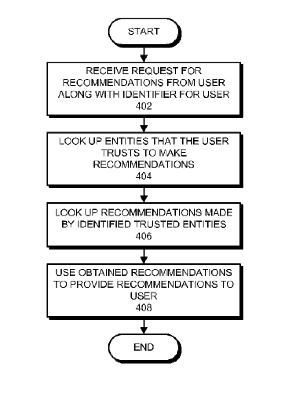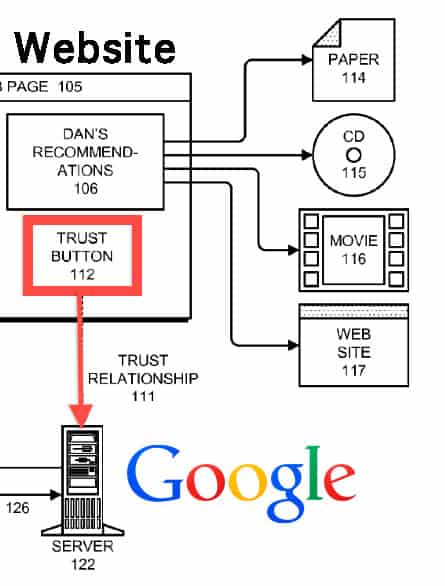On June 24th 2014 Google was granted a patent for a trust-based recommendation system that’s been labelled as the trust button patent. This new system adds to the company’s earlier patent for “Trust Rank”, which was approved in October 2009.
By looking at how the trust button works in more detail, it’s possible to make some early predictions about how Google will define “trust” in the future, and how trust will flow between users and websites.
What Is The Google Trust Button?
As Bill Slawski reported earlier this month, the trust button patent gives Google a more specific way of collecting trust recommendations or endorsements. The patent abstract states that:
the system performs a computer-based lookup operation to identify trusted entities that the user trusts (or is likely to trust) to make recommendations. Next, the system performs another computer-based lookup operation to obtain recommendations associated with the identified trusted entities. The system then uses the obtained recommendations to provide recommendations to the user. In a variation on this embodiment, the system additionally receives information indicating that the user trusts recommendations associated with an entity. The system then stores a corresponding record for the trust relationship between the user and the trusted entity in a computer-based lookup structure to facilitate subsequently identifying trusted entities that the user trusts to make recommendations.

The above diagram was included as part of the patent application (annotations added by me). Here’s how it seems to work:
STEP 1: User visits a website
STEP 2: User indicates “trust” in website
STEP 3: Google records this “trust endorsement”
STEP 4: Google recommends this website to users in the future
What’s interesting here is the technology behind steps 2 and 4, raising the questions:
- How can users indicate they trust a website?
- How will Google serve these recommendations back to the user?
What We Already Know

User-generated recommendations are nothing new. In fact, there are hundreds of examples already in use, some of which Google already employs on its own sites:
- Social recommendation (tweet, +1, like etc)
- Endorsement (e.g. LinkedIn)
- Thumbs Up
- Upvote
- Comment
- Star rating
- Review
If a Google+ (or Chrome) user is logged in while browsing the web, they already get ‘recommendations’ based on their previous search history. In this case, search history is the indicator of trust. If, say, I visit searchengineland.com every day, Google knows I trust the site’s content and pushes it to the top of my results in the future. At the moment, my search behaviour affects only my results (when logged in to G+). The new patent indicates a desire to serve my recommendations to other searchers too.
Transferring Trust

Despite G+ and Chrome giving enhanced data to Google, the majority of searchers are still using the engine without being logged in. We know that search engine users are identified by data strings (based on IP, cookies etc), but Google’s new patent shows a switch from collecting passive trust to eliciting active trust recommendations. Likes, +1s and other trust indicators are active recommendations, in that the user must participate in an action for them to be recorded. In the new patent, active website recommendations will be used on a larger scale:
receiving a request from a first user for recommendations; comparing web visitation patterns of the first user and a second user; identifying, from the comparison, a trust relationship between the first user and the second user, wherein the trust relationship includes a trust level that indicates a strength measurement for the trust relationship, and wherein the trust relationship decays when the trust relationship is not affirmed by the first user or the second user; identifying one or more web sites visited by the second user based on the web visitation patterns of the second user; identifying recommendations from the one or more web sites based on the trust relationship; providing the recommendations to the first user; receiving input directly from the first user indicating that the first user trusts a first recommendation of the recommendations associated with the second user; inferring a first topic associated with the first recommendation; and increasing a first topic-specific trust level of the trust relationship between the first and the second user in response to receiving the input directly from the first user, the first topic-specific trust level based on the first topic.

If you hate patent jargon, let’s break it down:
For the example given, we’ve got 3 entities: User 1, who’s looking for a recommendation, User 2 that visits similar websites to User 1, and a Website, that User 2 visits. This is standard data that Google’s been collection for years. Here’s how that data will be connected in order to provide Google Trust results:
STEP 1: User 1 requests recommendations
This could indicate a new search feature, in a similar vein to Google Images or Google Scholar. This time, it would be something like ‘Google Trust’, a special search that provides only user-recommended results. It’s possible, however, that the user ‘request’ will be more passive, i.e. assumed to be requested when performing any search while logged in.
STEP 2: User 1 is matched with User 2
Factors such a previous search history, age, gender, interests etc will make up part of each user’s profile, in this case User 1 and User 2 are deemed to have a trust relationship, based on their similar profiles.
STEP 3: The trust relationship between User 1 and User 2 is measured by establishing how recent the trust relationship is (more recent = stronger relationship).
STEP 4: Website recommendations
The websites visited by User 2 recommends additional sites. These recommendations are based on:
– The trust behaviour of the website owners (if it’s a personal blog) or page author on a larger site.
If you read the full patent document, you’ll learn that site owners (or authors) can list their recommendations on the site.
These recommendations can be for:
– websites
– products (music, movies , books etc)
and can “also include numerical ratings“. Sort of like a personalised metacritic plugin for all the products and websites you use.
STEP 5: “Receiving input directly” from User 1
User 1 reports back on the recommendations, indicating whether they agree with them or not. This is clearly worded as an action, which will most-likely involve the use of a button or other direct feedback system. The patent diagram clearly depicts a “Trust Button”:

STEP 6: An algorithm guesses (“infers”) the topic of the recommendation and logs it for future use. If User 1 likes what User 2 recommends, the trust relationship is strengthened.
Of course, the User 1 and User 2 example is grossly simplified. In reality, Google’s trust algorithm will compare User 1 to millions of other users and establish a number of trust relationships.
How Website Recommendations Work

Part of Google’s Trust Button patent involves website recommendations. Specifically, a trust plugin that shows recommended content (with numerical ratings) that site users can choose to endorse/follow. There will be a nice “Trust Button” (coded in an iframe) to click to add points to a certain product or website, which will in turn affect the recommendations you and similar users receive in the future.
What’s more, websites will also be able to include a “vanity page“, which shows how many people recommend the site. I believe that the success Google had getting webmasters to implement authorship (in return for the now defunct image snippets) will give them confidence that authors will be quick to jump on board with any new ‘trust schemes’ they implement. And why wouldn’t we? We’re already doling out trust with dofollow links and LinkedIn recommendations, +1s and retweets, so it’s nothing new. I predict that Google will seek to become the dominant website endorsement provider and will presumably tie the feature into the existing G+ system, thus growing the network.
Click Circles, Spam and the Future of Trust

If trust buttons were rolled out onto most of the websites you visit, would people just start paying for clicks to try and rank higher?
Matt Cutts, head of Google’s Web Spam team, explained why simple endorsements don’t work, during a keynote discussion at SMX Advanced 2014:
“We’re open to looking at signals but I am extremely skeptical about whether that would work for all kinds of reasons. […] The very first feature I ever got into the Google Toolbar were called “voting buttons” and they were happy/frowny faces, you know, and you could click “happy” or you could click “frowny” on a given page, and I was like “this is great, we’re going to have engagement figures from users that’s going to tell us whether a site is real or not”. And 75% of all the clicks were on the “happy” button and we quickly learned about Stanford students who were in click rings, who were all like “I’ll click happy face on your page if you click happy face on my page”. So I have always been skeptical about this sort of data, not only would it be noisy and skewed, but people would jump right in and try to scam it. “
Happy and frowny faces, though, are a very primitive rating system. With the new Trust Button patent, Google has something much harder to game, and much more powerful.
Summary
– Google gets a patent granted for a new “Trust Button” feature.
– Trust buttons will work like +1s
– Users can indicate trust in websites and products by clicking a “trust button”
– Trust may also be accrued by website visits
– Trusted entities will have a “Trust Score” rating
– Webmasters can show things they “trust” on any site page, using an iframe
– Webmaster can display a vanity page showing the users that “trust them”
– Search results will be customised to show trusted results from similar users and websites.
Trust buttons are set to be the next update in Google’s effort to create a person-centred Internet. To compete, your sites need to have personality. To illustrate, here are some parting words from Matt Cutts’ SMX speech (March 2014):
“It’s easier to be real than to fake being real. The era of shortcuts that would guarantee number one rankings is quickly coming to an end. And, at this point, it’s easier just to have those authentic conversations and do the work and get to be known the honest way because that’s what stands the test of time.”

